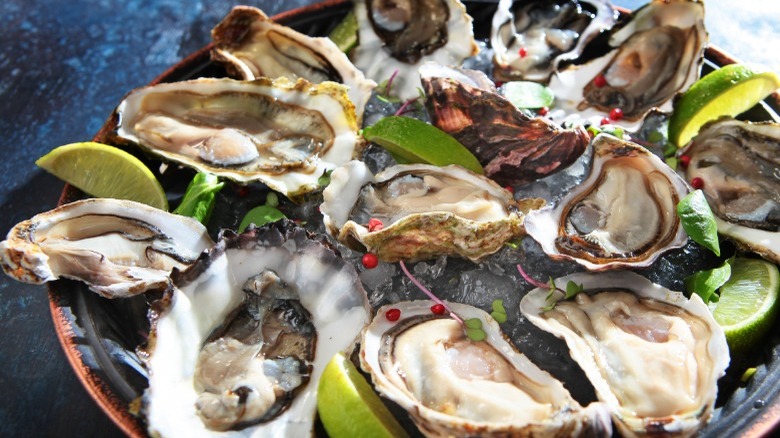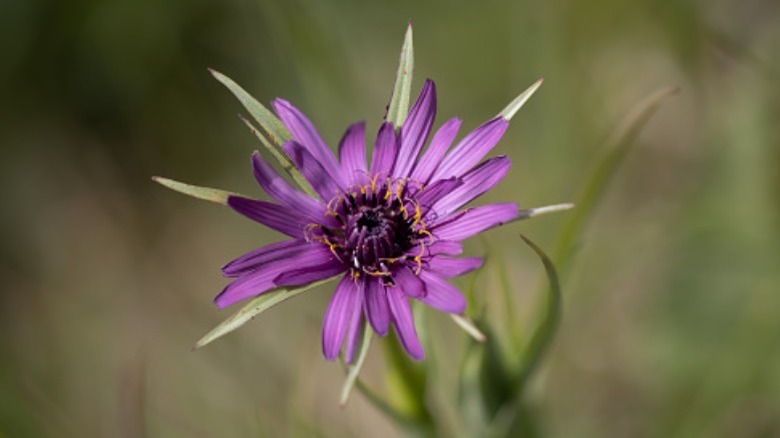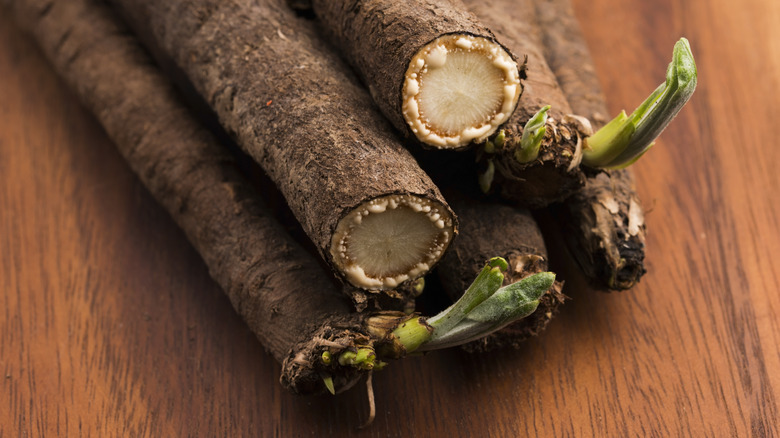What Is Salsify And How Do You Cook With It?
Say the phrase "root vegetables" and most people think of potatoes, carrots, onions, and beets. Few, if any, would come up with salsify — Tragopogon porrifolius, in scientific lingua — one of the most overlooked members of this food group. It looks like a parsnip or carrot. The thin, stick-like vegetable belongs to the Asteraceae family, which also includes dandelions, dahlias, endive, and lettuce.
Salsify has a long history in Europe, having been grown since the days of the ancient Greeks and Romans. In the U.S., the vegetable enjoyed some popularity during colonial times. Thomas Jefferson even experimented with growing the vegetable in his garden after getting samples of the plant from western explorers Meriwether Lewis and William Clark. And the Victorians were also huge fans of the plant, which has both edible roots and leaves. But it has since fallen out of favor, and it can be tough to come by these days.
What does salsify taste like?
Salsify has a couple of nicknames, including oyster plant and vegetable oyster, which provide clues to its flavor. But does it really taste like shellfish? That's a matter of some intense debate, but there is definitely a mineral quality to this vegetable that could be interpreted as coastal in flavor. Others claim that these roots taste more like artichoke, another vegetable found in the Asteraceae family. Eaters may also detect a hint of licorice as well. Raw or cooked, the overall taste of salsify is fairly mild.
This remarkable plant is completely edible so the greens can be eaten as well. Salsify leaves can be compared to spinach, and they would make a nice addition to a salad. Some think that the light section of the leaves tastes a bit like leeks, especially when sautéed. The vegetable's seeds and flowers can be eaten as well. It's unclear how tasty the seeds are, however. Like dandelions, the seeds of salsify attach themselves to the white fluffy plant material to help disperse them.
How to cook with salsify
Incredibly versatile, salsify can be served raw or cooked. For raw preparations, it's best to use young versions of the vegetable. The younger root is more tender, but it still can add a nice crunch to a salad. The greens from younger salsify plants also work better in salads. The root itself can be peeled and eaten raw as well. Try cutting the root into matchsticks and adding in place of cabbage or carrots in coleslaw and other salads.
There are a number of ways to cook salsify, which all start with peeling its outer skin. The peeled root will brown if exposed to air so it's important to place it in water with lemon or vinegar to prevent discoloration while getting ready to cook salsify. Like other root vegetables, salsify can be boiled or roasted. It can be thinly sliced and used as the star ingredient in popular potato preparations, such as gratin. It also pairs well with butter, cheese, and cream. Salsify also makes a nice addition to soups and stews. It could be great in a seafood chowder, considering that salsify has a slightly mineral taste. Some also rave about deep frying salsify after par-boiling the roots.
Where to buy salsify
Finding fresh salsify is a bit of a challenge as it's unlikely that it will be in a local supermarket alongside the carrots and parsnips. Specialty grocers and farmers' markets may be the best bet for locating this uncommon vegetable. Shopping online may be another way to get your hands on this elusive vegetable. If you're feeling really ambitious, there are a number of companies that sell salsify seeds so you can grow your own.
The peak season for salsify is October to January. Much like selecting a carrot or parsnip, the salsify root should be firm. Avoid blemished ones. If it's impossible to find fresh salsify, a few companies sell a canned version of the vegetable. These can be ordered online or found in some gourmet food shops. Some canned salsify comes already cooked — it's a quick way to try out this unique vegetable.
Nutritional information about salsify
Roughly one cup of sliced raw salsify has 109 calories, 25 grams of carbohydrates, 4.4 grams of protein, and 4.4 grams of fiber, per the Nutrition Value website. This fiber-rich vegetable contains an array of important vitamins and minerals, including iron, calcium, and vitamin C. Given these attributes, it's surprising that salsify isn't more popular. Some even call it a superfood.
With all of these healthy components, it's no surprise that the plant was believed to have healing powers. Historically, salsify was used to treat liver and gallbladder problems. A more modern view of the vegetable claims it can help increase immunity and manage blood pressure because of the nutrients it contains. Salsify's high level of vitamin C helps the body create white blood cells, which supports the ability to fight viruses. Salsify also has potassium and calcium –- two significant parts of managing blood pressure.
One caveat, however, about eating salsify. It contains a complex carbohydrate called levulin that may be hard for some people to digest. However, this type of carbohydrate, as a form of soluble fiber, helps reduce cholesterol levels.
Other varieties of salsify
Historically, there have been two main varieties of salsify: white salsify (Tragopogon porrifolius) and black salsify (Scorzonera hispanica). Both vegetables have long, thin roots with light interior flesh. And while they have similarities, it is evident by their scientific names that there are actually two different plants. Some don't consider black salsify as a real form of salsify because of this. Black salsify is sometimes referred to as scorzonera to make a clear distinction. Another name is Spanish salsify.
Black salsify and white salsify are related, however. They are both part of the Asteraceae family. And in terms of eating and cooking these vegetables, they are handled the same way. Black salsify needs to be peeled before eating and can be enjoyed both cooked and raw. It works well as a substitute for any root vegetable in any recipe. The taste of black salsify is also similar to white salsify.





